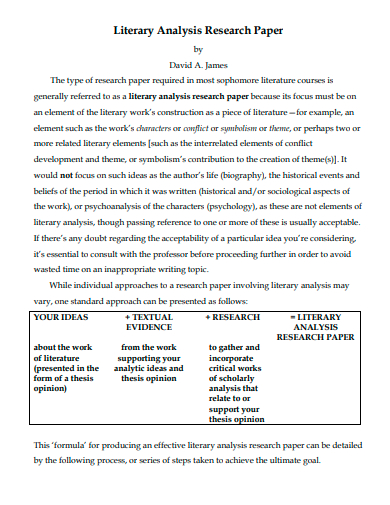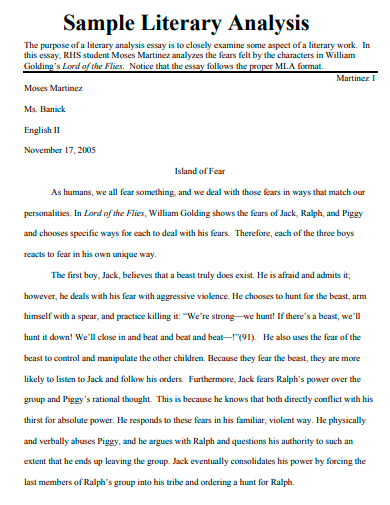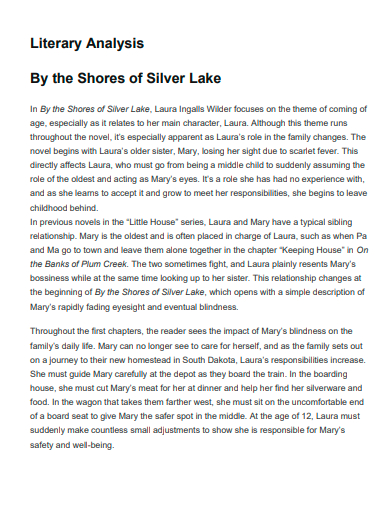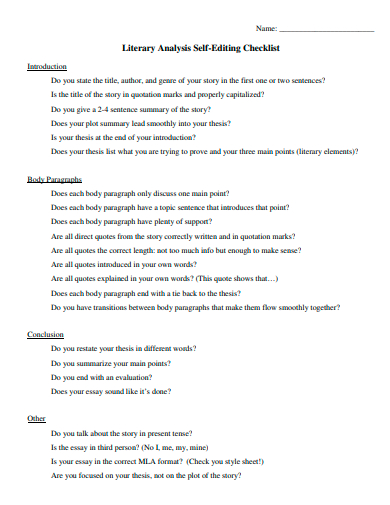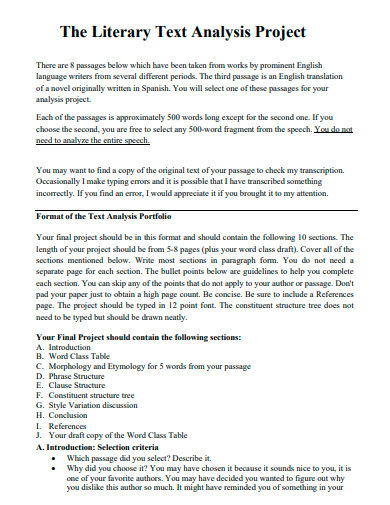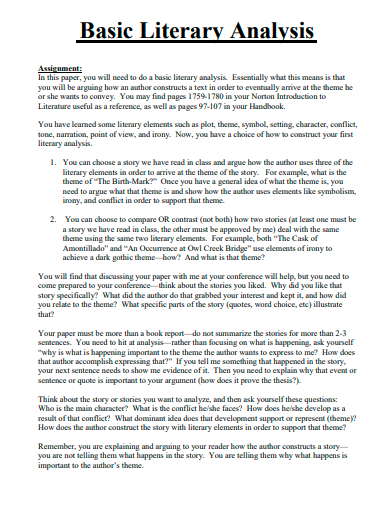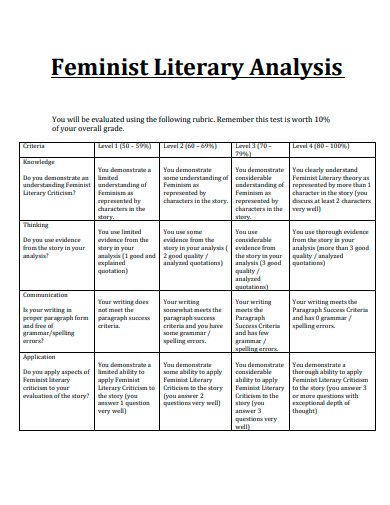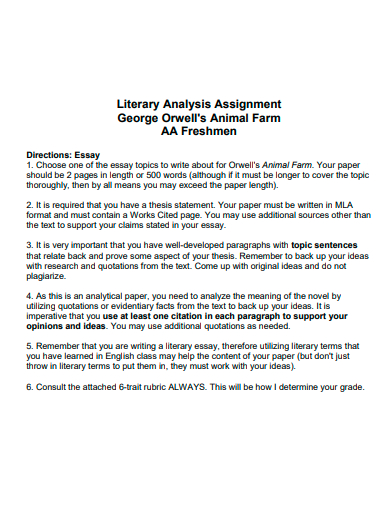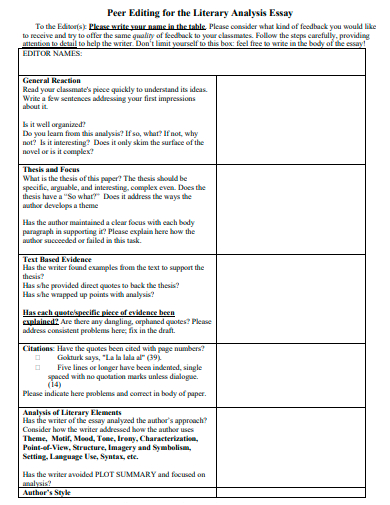There are various ways and reasons for reading different books. You might find yourself reading a book to pleasure yourself with exciting and engaging stories about adventures that can be set at different times or places. You can also read when you want to spark inspiration, look for guidance, compose a research analysis, or help you reflect on your past. Another reason to read a book is to analyze its content or elements such as the characters, tone, imagery, and setting, and how the author utilizes these elements to create an effect on the readers.
FREE 10+ Literary Analysis Samples
1. Literary Analysis Research Paper
2. Sample Literary Analysis
3. Literary Analysis Example
4. Printable Literary Analysis
5. Literary Analysis Self-Editing Checklist
6. Literary Text Analysis Project
7. Literary Analysis Paper
8. Basic Literary Analysis
9. Feminist Literary Analysis
10. Literary Analysis Assignment
11. Literary Analysis Essay
What is a Literary Analysis Template?
A literary analysis template is a document often required to be accomplished by college students as a part of their project or assignments which ranges from English literature to history. It is a type of research paper that studies a text, interprets its many meanings, and explores the reasons why the author made certain choices in the literature. This analysis template can be used when researching or studying literary essays, novels, plays, short stories, poetry analysis, and other types of literary writing.
How to Compose a Literary Analysis?
One task that is given to a student is assessing the plots, traits of the characters, occurrences, and the overall substance that the author is trying to communicate to their readers. A literary analysis is a type of argumentative essay that aims to determine the clear structure and flow of ideas a literature writing has by examining its parts and sections such as its introduction, thesis statement, body, and its conclusion. A literary analysis research paper can focus on a certain aspect like the theme, setting, characters, and plot which means attentive evaluation of any of these elements.
Step 1: Evaluate the Literature Writing
To evaluate the literary work, you’ll have to read the work carefully more than once. Familiarize yourself with the major aspects of the literary work like the main theme, characters, plot, and how the author communicates his points of view and thoughts.
Step 2: Collect Arguments for Support
Once you have familiarized yourself with the elements mentioned above, gather pieces of elements to support your arguments like passages in the text.
Step 3: Draft an Outline
Writing a rough paragraph outline or synopsis of the work you are studying is one of the first steps in writing an actual literary analysis. This outline will serve as your analysis’ framework and will help you make a logical argument while also focusing on your points.
Step 4: Provide a Thesis Statement
Your thesis statement must connect the ideas of the author to the arguments you are making in your literary analysis. This part of your paper must explain how and why your argument is important for better understanding literature writing.
Step 5: Write your Analysis
In your actual analysis, each of your paragraphs should support a single idea and must explain its points in an easy way to enable your reader to understand it quickly. After you write your analysis, review your work to make sure that is error-free.
FAQs
What are the common types of literary analysis?
The common types of literary analysis you can use are theoretical which focuses on mapping pieces of relevant theories, close reading which offers deeper insights into the author’s decisions, and applied which explores how the work’s elements relate to one’s personal experiences, comparative or synergistic which compares work to similar writings, and contextual or historical which focuses on external factors relevant to the work.
What are the parts of literary analysis?
The main elements or parts of literary analysis are the introductions which include the basic information about the literary work, the body which focuses on answering questions the readers have about the writing, and the conclusion which explains the analysis’ thesis and summarizes the main points of the paper.
What should be included in literary analysis?
The common factors that should be in the literary analysis are the genre and type of literature you are analyzing, rigorous evaluation of the main characters, the outline of the plot and main ideas, a review of the general theme, a description of the piece’s symbolism, and inspection of the writing’s structure and style.
A literary analysis template is a document used to write an outline essay or evaluation that an individual came up with after examining parts of a literary work which refer to character analysis, imagery, plot, and setting as well as determining and understanding the message the work’s author is trying to convey and its effects to the readers.
Related Posts
FREE 10+ Failure Mode and Effects Analysis Samples in PDF
FREE 10+ Make or Buy Analysis Samples in PDF
FREE 10+ Fishbone Root Cause Analysis Samples in PDF
FREE 11+ Cost Volume Profit Analysis Samples & Templates in PDF | MS Word
FREE 6+ Corporate Portfolio Analysis Samples in PDF
FREE 10+ Fault Tree Analysis Samples in PDF
FREE 10+ Comp Analysis Samples in PDF
FREE 10+ Fishbone Analysis Samples in PDF
FREE 10+ Individual Swot Analysis Samples in PDF
FREE 10+ 5 Year Analysis Samples in PDF
FREE 10+ Benefit Costs Analysis Samples in PDF
FREE 10+ Job Hazard Analysis Samples in PDF
FREE 10+ Primary Source Analysis Samples in PDF
FREE 10+ Critical Path Analysis Samples in PDF
FREE 10+ Competition Analysis Samples in PDF

